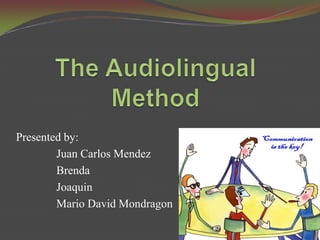
Audio lingual method 111
- 1. Presented by: Juan Carlos Mendez Brenda Joaquin Mario David Mondragon
- 2. Definition The Audio-lingual Method is a method of foreign language teaching which emphasizes the teaching of listening and speaking before reading and writing. It uses dialogues as the main form of language presentation and drills as the main training techniques. Mother tongue is discouraged in the classroom.
- 3. Background The Audio-lingual Method was developed in the U.S. during the Second World War. At that time, the U.S. government found it a great necessity to set up a special language-training program to supply the war with language personnel. Therefore, the government commissioned American universities to develop foreign language program for military personnel.
- 4. Thus the Army Specialized Training Program (ASTP) was established in 1942.The objectives of the army program was for students to attain conversational proficiency in a variety of foreign languages. The method used was known as the “informant method”, since it used a native speakers of the language, the informant, and a linguist. The informant served as a source of language for imitation, and the linguist supervised the learning experience. The intensive system adopted by the army achieved excellent results.
- 5. Behaviorist psychology The learning theory of Audiolingualism is behavioral psychology which is an empirically based approach to the study of human behavior. Behaviorism tries to explain how an external event (a stimulus) caused a change in the behavior of an individual (a response) without using concepts like “mind” or “ideas” or any kind of mental behavior. Behaviorist psychology states that people are conditioned to learn many forms of behavior, including language, through the process of training or conditioning.
- 6. Basic Principles Separation of language skills into listening, speaking, reading and writing, with emphasis on the teaching of listening and speaking before reading and writing; Use of dialogues as the chief means of presenting the language; Emphasis on certain practice techniques: mimicry, memorization and pattern drills; Discouraging the use of the mother tongue in the classroom
- 7. Objectives The general objective of the Audio-lingual Method is to enable the target language communicatively, Short-range objectives include training in listening comprehension, accurate pronunciation, reading comprehension and production of the Audio-lingual Method are the development of mastery in all four language skills, beginning with listening and speaking, and using these as a basis for the teaching of reading and writing. Long-range objective, or the ultimate goal, is to develop in the students the same types of abilities that native speaking have, to use it automatically without stopping to think.
- 8. Techniques Repetition drill:This drill is often used to teach the lines of the dialogue. Students are asked to repeat the teacher’s model as accurately and as quickly as possible. Substitution drill:The students repeat the line from the dialogue which the teacher has given them, substituting the cue into the line in its proper place. Question-and-answer drill:The drill gives students practice with answering questions. The students should answer the teacher’s question very quickly. It is also possible for the teacher to cue the students to ask questions as well
- 9. Expansion drill:This drill helps students to produce longer sentence bit by bit, gradually achieving fluency. The main structure is repeated first, then students have to put cue phrase in its proper place. Clause combination drill:Students learn to combine two simple sentences into a complex one. Background build-up drill ( or back chaining: This drill is used when a long line of dialogue is giving students trouble. The teacher breaks down the line into several parts. The students repeat a part of the sentence, usually the last phrase of the line.
- 10. Chain drill :A chain drill gets its name from the chain of conversation that forms around the classroom as students, one-by-one, ask and answer questions of each other. The teacher begins the chain by greeting a particular student, or asking him a question. That student responds, and then turns to the student sitting next to him. Completion:Students hear an utterance that is complete except for one word, and then repeat the utterance in completed form. Use of minimal pairs:The teacher works with pair of words which differ in only one sound; students are first asked to find the difference between the two word and later to say the two words.
- 11. Advantages The first method to have a theory. Making language teaching possible to large groups of learners Emphasizing sentence production , control over grammatical structures and development of oral ability. Developing simple techniques and making use of language lab. Developing the separation of the language skills
- 12. Disadvantages Weak basis of its theory Not developing language competence , lack of effectiveness , and boredom caused by endless pattern drills. Learners having little control over their learning. Teacher’s domination of the class . Teacher-oriented materials.
- 13. !!!